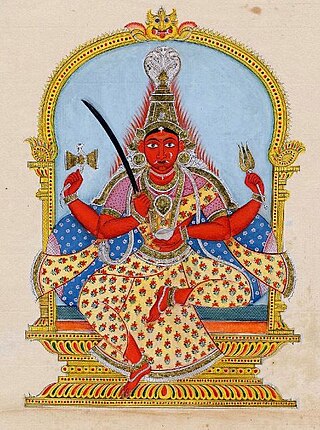
Mariamman, often abbreviated to Amman, is a Hindu goddess of weather, predominantly venerated in the rural areas of South India. Her festivals are held during the late summer/early autumn season of Ādi throughout Tamil Nadu and the Deccan region, the largest being the Ādi Thiruviḻa. Her worship mainly focuses on bringing rains and curing diseases like cholera, smallpox, and chicken pox. Mariamman is worshipped in accordance with local traditions such as Pidari or the Gramadevatai. She is considered as a guardian deity by many South Indian village-dwellers.
Marthandam is a major trade centre in Kuzhithurai municipality across National Highway in the Kanyakumari district of Tamil Nadu, India. Formerly known as Thoduvetty, it was a portion of Kanyakumari district which was added to the state of Tamil Nadu on 1 November 1956.

The ChottanikkaraDevi Temple is a temple dedicated to the Hindu mother goddess Bhagavati Lakshmi. She is believed to be residing in Chottanikkara (Mahalakshmi) along with her Husband Maha Vishnu. The main deity is also considered as Lakshmi Narayana according to the temple legend. The temple is Classified one among the 108 Abhimana Kshethram of Vaishnavate tradition. The temple is located at Chottanikkara, a southern suburb of the city of Kochi in Ernakulam district, in the state of Kerala, India and is one of the most popular temples in the state. The temple is also known for conducting exorcism.
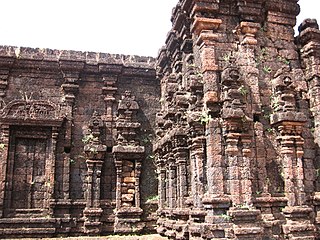
The Rajarajeshwara temple is a Shiva temple located in Taliparamba in Kannur district of Kerala State of India. The temple is regarded as one of the existing 108 ancient Shiva Temples of ancient Kerala. It also has a prominent place amongst the numerous Shiva temples in South India. It had the tallest shikhara amongst the temples of its time. The Rajarajeshwara temple has a top of about 90 tonnes. If any problem is encountered in the other temples of South India, devotees seek a solution in this temple through a prashnam, a traditional method of astrological decision-making. The prashnam is conducted on a peedha outside the temple.
Azhakodi Devi Temple or Azhakodi Devi Mahakshethram is a Hindu temple located in Thiruthiyad, Kozhikode District, Kerala, South India. It is one of the famous Devi temples, situated hardly 1.5 km away from the Mofussil Bus stand and 2.5 km from the KSRTC Bus stand, the area still retains the beauty and charm of un-spoilt rural settings within the heart of the Kozhikode city. The temple and the Kalayana Mandapom are administered by the Malabar Devaswom Board.

Bhadrakali is a Hindu goddess. She is considered to be the auspicious and fortunate form of Adi Shakti who protects the good, known as bhadra.
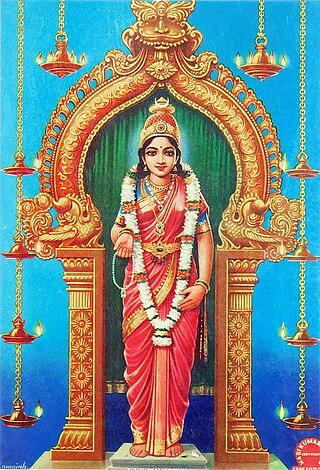
Devi Kanya Kumari is a manifestation of the Hindu goddess Mahadevi in the form of an adolescent girl. She is variously described by various traditions of Hinduism to either be a form of Parvati or Lakshmi. She is also worshipped as an incarnation of the goddess Bhadrakali by Shaktas, and is known by several names such as Shrī Bāla Bhadra, Shrī Bāla, Kanya Devi, and Devi Kumari.
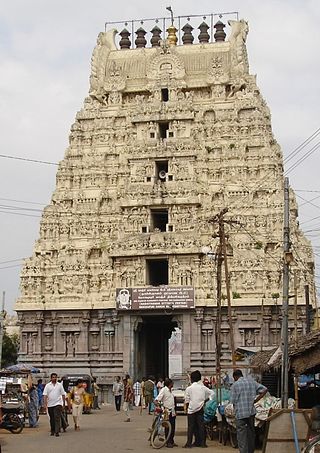
The Sri Kamakshi Amman Temple is an ancient Hindu Temple dedicated to the goddess Kamakshi, one of the highest aspects of Adi Parashakti, the mighty goddess in Shaktism. The temple is located in the historic city of Kanchipuram, near Chennai, India. The temple houses one of the 108 Divya Desams of Vishnu and is called Tirukalavanur. The temple is dedicated mainly to Kamakshi and then to Vishnu in his form of Varaha. The temple is glorified by the 6th-9th century Vaishnavite Alvars in the Naalayira Divya Prabandham. Its construction is credited to the Pallava kings, whose capital was in the same city. This temple, along with the goddesses of Madurai and either Varanasi or Thiruvanaikovil, are the important centers of Shaktism in the state of Tamil Nadu. The present temple is also known as Kamakoti Peetha or Kamakota Nayaki Kovil, where Tripura Sundari had settled after killing a demon. This ancient temple was mentioned in Perunaraatrupadai, an ancient Tamil literature that praises the renowned Sangam era. King Thondaiman Ilandiraiyan of the Pallava dynasty, who ruled Kanchipuram, constructed the temple. Kamakshi is worshipped in the shrine in 5 forms, one of them was a golden idol, which was transported to Thanjavur due to the Muslim invasions of Kanchipuram. There are no other goddess temples in the city of Kanchipuram, apart from this one, which is unusual in a city that has hundreds of traditional temples. There are various legends that account for this fact.

Thirumandhamkunnu Temple is a historically significant Hindu temple in Angadipuram, which was the capital of Valluvanad Rajavamsham, in Malappuram district, Kerala state, South India. The temple deity, Thirumandhamkunnil amma, was the paradevatha of the kings of Valluvanad, the local feudal kings ruled the area in the Middle Ages. The Nair warriors of Valluvanad king set out from this temple to Thirunavaya, to participate in the famous Mamankam festival. A memorial structure called the chaver thara can be found in front of the main entrance of the Thirumanthamkunnu Temple.
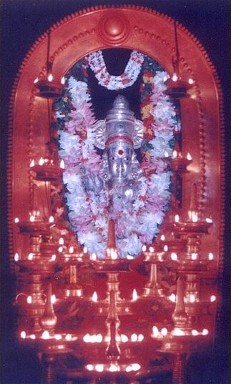
Manapullikavu is a Hindu temple located in Palakkad city, Kerala of India. The temple is most famous for the annual festival that takes place in the temple known as Manappullikavu Vela. Manapullikavu is also a major residential area in Palakkad city comprising apartments and residential colonies. Manappulikavu is ward 27 of Palakkad Municipality.

The Vilwadrinatha Temple is a Hindu temple in Thiruvilwamala, a town in the city of Thrissur, Kerala, India. The principal deities are Rama, the seventh incarnation of the god Vishnu, and his brother, Lakshmana. It figures among the Abhimana Kshetrams in Vaishnavite traditions. This is one of the four major Rama temples in Kerala — the other three are in Thriprayar, Kadavallur, and Thiruvangad. The temple houses an idol of Lakshmana, which is rare in India. Vilwadrinatha Temple is located in the centre of the community of Thiruvilwamala, atop a 100-foot-high hillock. Visible from the temple is Bharathappuzha, the second-largest river in Kerala, which flows past the temple's northern side from around 3 kilometres away.
Mandaikadu Bhagavathy Amman Temple is a Hindu Temple where Devi Parvathi is the prime deity. It is located near Colachel in the Western coast of Kanniyakumari District, Tamil Nadu. This is one among the most renowned and most important Hindu temples in Kanniyakumari district.

The Sreevallabha Temple is a highly orthodox Hindu temple dedicated to Sreevallabha, a form of Vishnu. It is located in the citty of Thiruvalla, in India.
Pazhayannur is a town and panchayath in Thrissur district, in the state of Kerala, India. The eminent mridangist, Palghat Mani Iyer was born here.
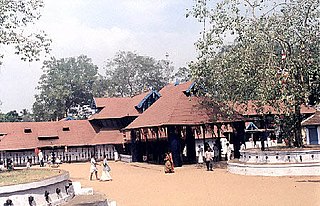
Sree Kurumba Bhagavati Temple is a Hindu temple at Kodungallur, Thrissur District, Kerala state, India. It is dedicated to the goddess Bhadrakali, a form of Mahakali or simply Durga or Aadi Parashakthi worshipped and significantly revered in Kerala. The goddess is known also by the names "Sri Kurumba"". This temple is the head of 64 Bhadrakali temples in Kerala. This Mahakali temple is one of the oldest functioning temples in India. This is attested by numerous Tamil poems and inscriptions of different times. The goddess of the temple represents the goddess in her fierce ('ugra') form, facing North, featuring eight hands with various attributes. One is holding the head of the demon king Daruka, another a sickle-shaped sword, next an anklet, another a bell, among others. Routine worship at the temple every day at 03:00 and ends at 21:00 local time.

Nainativu Nagapooshani Amman Temple [Tamil: நயினாதீவு நாகபூசணி அம்மன் கோயில், romanized: Nayiṉātīvu Nākapūcaṇi Am'maṉ Kōyil - Meaning: Nainativu ; Nagapooshani ; Amman (Goddess)] is an ancient and historic Hindu temple located amidst the Palk Strait on the island of Nainativu, Sri Lanka. It is dedicated to Parvati who is known as Nagapooshani or Bhuvaneswari and her consort, Shiva who is named here as Nayinaar. The temple seems to have been mentioned in the Brahmanda Purana. The temple complex houses four gopurams ranging from 20–25 feet in height, to the tallest being the eastern Raja Raja Gopuram soaring at 108 feet high. The temple is a significant symbol for the Tamil people, and has been mentioned since antiquity in Tamil literature, such as Manimekalai and Kundalakesi. The present structure was built during 1720 to 1790 after the ancient structure was destroyed by the Portuguese in 1620. The temple attracts around 1000 visitors a day, and approximately 5000 visitors during festivals. The annual 16-day Mahostavam (Thiruvizha) festival celebrated during the Tamil month of Aani (June/July) - attracts over 100,000 pilgrims. There is an estimated 10,000 sculptures in this newly renovated temple.

The Mangadu Kamakshi Amman Temple is a famous pilgrim destination Hindu temple dedicated to goddess Parvathi, located in Mangadu, a suburb of Chennai, India. The term Mangadu means "Mango Forests or Mango Groves" and as the term implies this must have been a thickly wooded Mango groove in times of yore.
Velleswarar Temple is a Hindu temple dedicated to Lord Shiva and located in Mangadu, a suburb of Chennai, India. This is a mid-size temple spread over 2 acres and is among the 3 principal temples in Mangadu – the other 2 being the Sri Kamakshi Amman Temple and Sri Vaikunda Perumal Temple. The temple is managed by the HRCE Department of the Government of Tamil Nadu. It is situated about 2 kilometers from Sri Kamakshi Amman Temple in Mangadu.
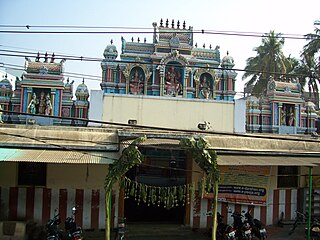
Vekkali Amman Temple is a temple dedicated to the Goddess Vekkaali, a form of the goddess Kali. It is located in Woraiyur, a neighbourhood in Tiruchirappalli, Tamil Nadu, India. The central shrine of the temple houses the image of Vekkali Amman and the major feature of the temple is the absence of roof over the sanctum. The temple is known from the period of early Cholas, but there are no historical records. The people of Woraiyur see Vekkali Amman as their guardian deity. The temple has six daily rituals in its calendar and celebrates six annual festivals. The temple chariot is made of gold and was launched during 2010. The temple is maintained and administered by the Hindu Religious and Endowment Board of the Government of Tamil Nadu.
Sreekanteswaram Mahadeva Temple is a Hindu temple of the god Shiva situated in Thiruvananthapuram, in the Indian state of Kerala. Pazhaya Sreekanteswaram Temple is considered the original abode of the god.














